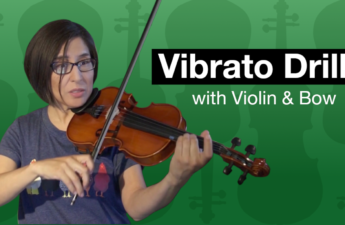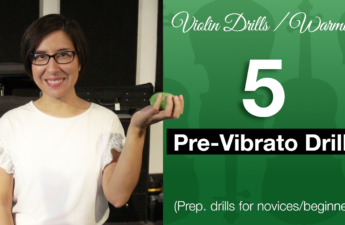The A major scale is the first I learned and like all scales, I use it to help me refine my intonation, posture, bowing.
To learn scales on a violin, you will need:
- A tuned violin. Make sure all of your strings are in tune. You can do this by using a tuner.
- You will also need to use a tuner or any audible reference that will help you hit the right note.
- If you are a novice, you may need to use a finger board guide or stickers to indicate where each finger needs to land to hit notes on the scale. I started out using a fingerboard guide, but decided to play without one so that I wouldn’t become dependent on one. The guide really helped me get a quick and easy start to playing – so for anyone who is in the beginning stage of playing, I highly recommend one.
Lets go over the A major one octave scale:
- Start with the open A
- First finger will hit B
- Second finger will hit C#, the second finger will be placed further away from the first finger; this is referred as a whole step – because your first and second fingers are not touching and as a result your skipping over
- the half step note between B and C# – which is C natural.
- Your third finger will hit D (notice that the third finger is only a half step away from the second)
- Then play the open E string
- First finger will hit F
- Second finger will go a whole step down to G#, further away from the first (as you did on the A string)
- Finally third finger will do a half step to play A
I practice and progress in three ways:
- I get started by playing the A scale using only my first three fingers and slow bow strokes.
- Once I learned my A major scale using your first three fingers, I took my practice further by using bow slurs. A bow slur is when you play more than 1 note per bow stroke. I start with playing two notes per bow stroke, then gradually add more notes until one day, hopefully, I’ll be able to play all notes per one bow stroke.
- Once I became accustomed to playing the scale with slurs, I took my practice further by including my 4th finger. In this case, I play the open E with my 4th finger on the A string. The fourth finger goes one entire half step down from the third finger to hit the E note.
It’s also important to practice the arpeggio of every scale you learn simultaneously. The Arpeggio for the A major scale is open A string, 2nd finger on C#, open E string and third finger on A.
My favorite way to practice scales is by using a playback piano track I created with a metronome beat. You can easily download the MP3 file here: A Scale Piano Track
For a detailed demonstration of the A Major scale, please watch the video below. Hit the like or subscribe button to show some support and to provide a bit more inspiration for videos like this one. Happy Practice everyone!


